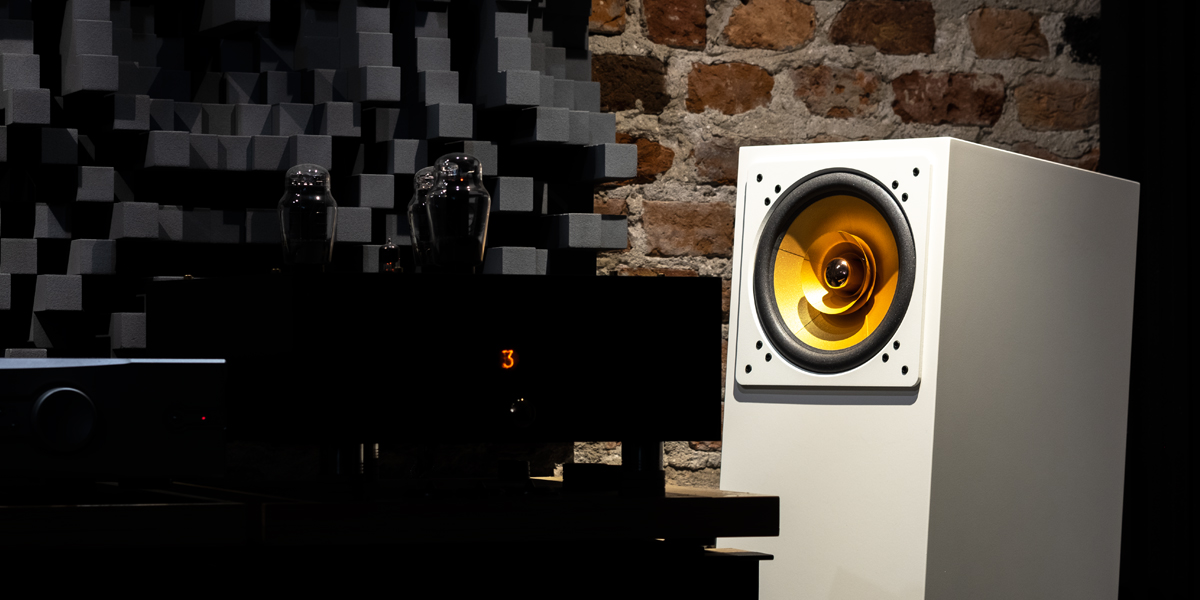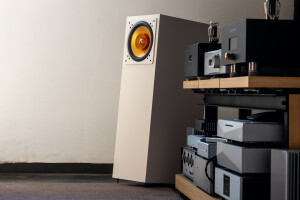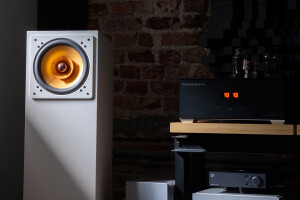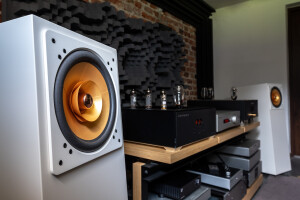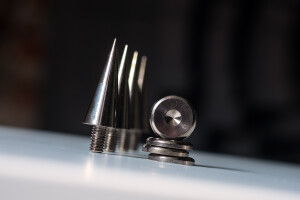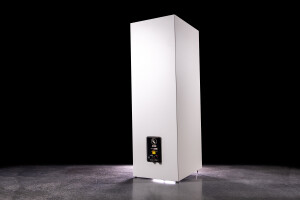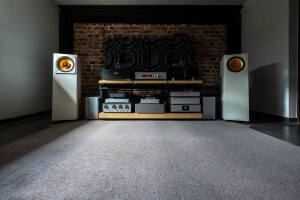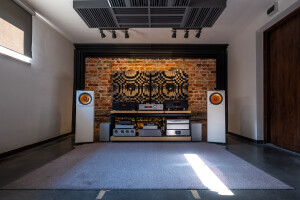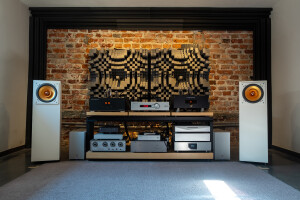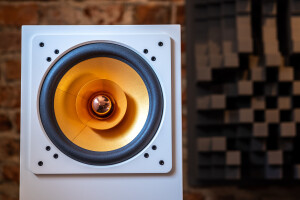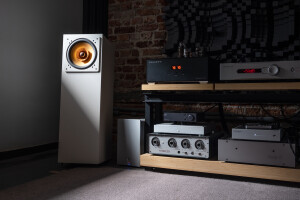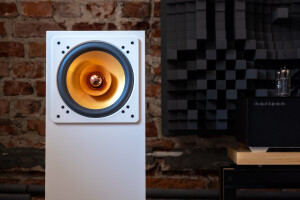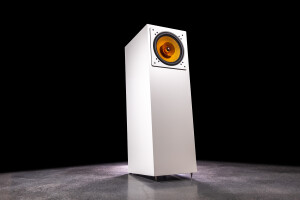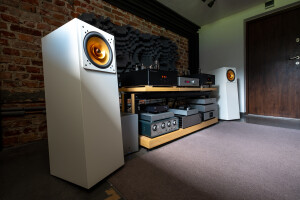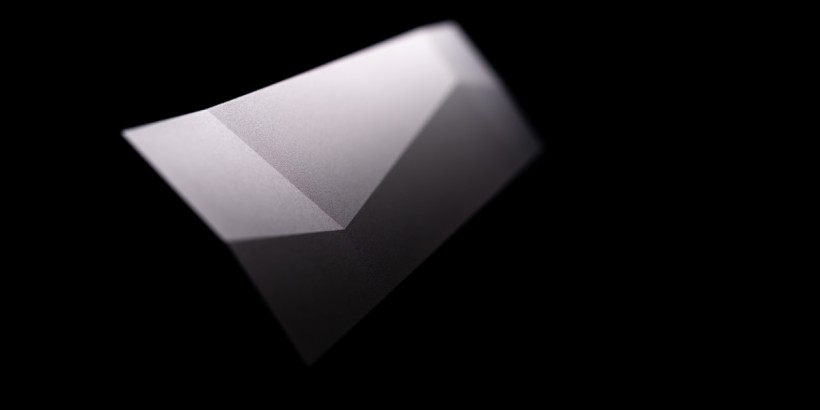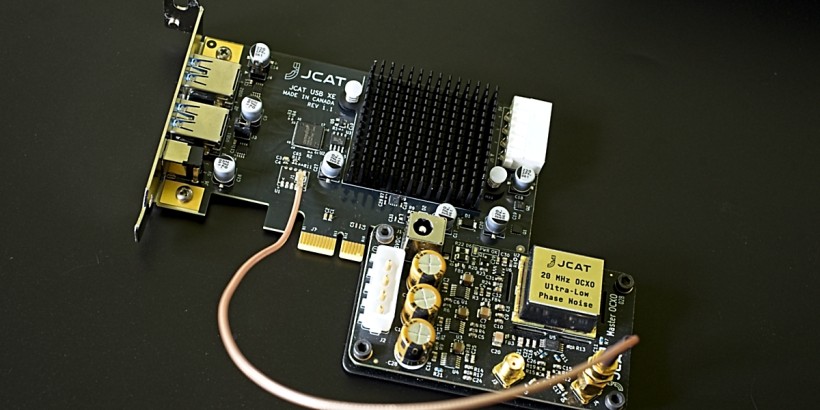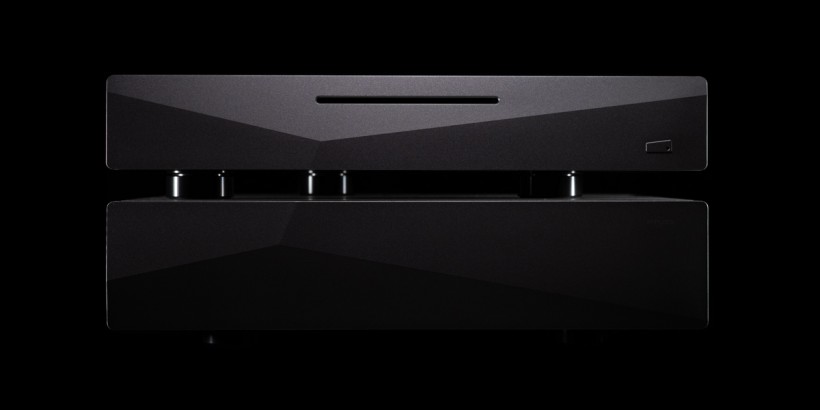Cube Audio Jazzon is its makers’ latest effort that takes a lot from their big Nenuphar speaker and sells for less than half its sticker. Now it’s time to find out whether this is too good to be true or not. Enjoy!
Widebander domestication
The local company Cube Audio is known for full-range speakers way outside of the mainstream and its founders – Grzegorz Rulka and Marek Kostrzyński – have been very effective in popularizing these niche exotic designs in recent years. So much so in fact that their rooms at various shows are usually packed. It’s no mystery why that happens, however. There visitors witness for themselves how passé the usual widebander stereotypes actually are, Cube Audio products stomp on them hard by making surprisingly gutsy wholesome sound from modestly styled and sized enclosures. More importantly, just one unassisted driver per box so successful in pulling this off turns widebander naysayers into a devout converts as easily as it gains friends among the non-audiophile audience not familiar with its orthodox kind. Although very purist by design, Cube Audio speakers are admirably easygoing, quite casual even. That makes them very special. Over the years Cube Audio has grown from a boutique workshop with two products to a thriving world-renown business with a larger roster that lists five 8” and three 10” loudspeaker models. The former lineup features Bliss (€6’900/pr), Magus (€8’900/pr) and Nenuphar Mini (€12’900/pr), also available as a standalone monitor (€12’900/pr) that sells for €24’900/pr with optional active Basis subs. Until recently the 10” family featured only Nenuphar (€16’900/pr) and its alike priced monitor sibling that with larger Basis modules demands €33’900/pr. On top of that Individuals into DIY can purchase standalone Cube Audio drivers and apply them as they see fit. The manufacturer’s F10 Neo/F8 Neo/F8 Magus/Fc8 transducers respectively sell for €6’690/2’990/5’490/3’290/1’790 per pair, so aren’t exactly affordable. Still, given how these units perform and how much can be done with them, the fact alone that they’re ready for the taking is a big plus.
Over the years Cube Audio has grown from a boutique workshop with two products to a thriving world-renown business with a larger roster that lists five 8” and three 10” loudspeaker models. The former lineup features Bliss (€6’900/pr), Magus (€8’900/pr) and Nenuphar Mini (€12’900/pr), also available as a standalone monitor (€12’900/pr) that sells for €24’900/pr with optional active Basis subs. Until recently the 10” family featured only Nenuphar (€16’900/pr) and its alike priced monitor sibling that with larger Basis modules demands €33’900/pr. On top of that Individuals into DIY can purchase standalone Cube Audio drivers and apply them as they see fit. The manufacturer’s F10 Neo/F8 Neo/F8 Magus/Fc8 transducers respectively sell for €6’690/2’990/5’490/3’290/1’790 per pair, so aren’t exactly affordable. Still, given how these units perform and how much can be done with them, the fact alone that they’re ready for the taking is a big plus. This report’s speaker set baptized Jazzon expands Cube Audio’s 10” roster and incorporates its latest F10 Select transducer. Although this essentially is the F10 Neo’s downscaled €3’700 lighter version (€2’990/pr), one wouldn’t be able to tell them apart upon comparing their cones, surrounds and machined 260 x 260mm aluminium baskets. The key difference between these drivers narrows down to the newcomer’s simpler ferrite magnet that replaced its much dearer sibling’s 81 neodymium slugs uniformly located within its acrylic compartment and apparently costly to make. This new motor reduced the former’s magnetic field strength across a 12mm gap from 2.4 to 1.7 Tesla and its sensitivity also went down from 92 to 90dB. These parameters called for a new speaker enclosure for the Jazzon that measures (W x D x H) 30 x 40 x 94cm and weighs 35kg, so in comparison to the big Nenuphar is 10cm shallower and shorter. On paper that’ not a lot, but in my room the latter was a noticeably larger product still.
This report’s speaker set baptized Jazzon expands Cube Audio’s 10” roster and incorporates its latest F10 Select transducer. Although this essentially is the F10 Neo’s downscaled €3’700 lighter version (€2’990/pr), one wouldn’t be able to tell them apart upon comparing their cones, surrounds and machined 260 x 260mm aluminium baskets. The key difference between these drivers narrows down to the newcomer’s simpler ferrite magnet that replaced its much dearer sibling’s 81 neodymium slugs uniformly located within its acrylic compartment and apparently costly to make. This new motor reduced the former’s magnetic field strength across a 12mm gap from 2.4 to 1.7 Tesla and its sensitivity also went down from 92 to 90dB. These parameters called for a new speaker enclosure for the Jazzon that measures (W x D x H) 30 x 40 x 94cm and weighs 35kg, so in comparison to the big Nenuphar is 10cm shallower and shorter. On paper that’ not a lot, but in my room the latter was a noticeably larger product still.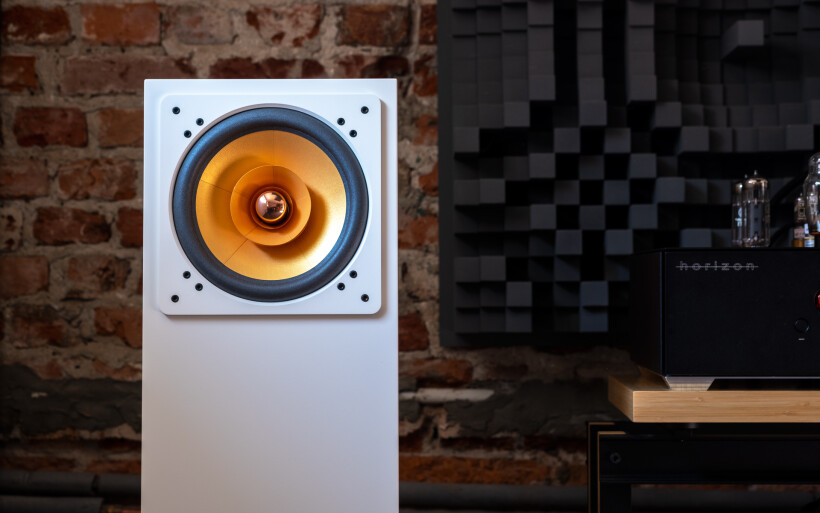 The Jazzon’s further specs list 10Ω nominal impedance, 40W max. power handling, 35Hz – 18kHz frequency response and its -3dB point set at 34Hz. It’s an enjoyably easygoing load perfectly happy about puny though carefully selected watts. As a proper Cube Audio type it belongs to the exclusive speaker club where only single full-range drivers rear-loaded with quarter-wave transmission lines folded inside their cabinets are allowed. The membership card gets you essentially a box with one transducer hardwired to its speaker terminals and that’s it. This in fact is all it takes for such products to work at their best, so any woofers, tweeters and crossovers are strictly forbidden. Cube Audio’s speakers aren’t crazy sensitive considering their breed, but on purpose. Marek and Grzegorz pursued maximum linearity and bandwidth rather than sensitivity. After auditioning their several designs I can only say that this was a very smart compromise indeed.
The Jazzon’s further specs list 10Ω nominal impedance, 40W max. power handling, 35Hz – 18kHz frequency response and its -3dB point set at 34Hz. It’s an enjoyably easygoing load perfectly happy about puny though carefully selected watts. As a proper Cube Audio type it belongs to the exclusive speaker club where only single full-range drivers rear-loaded with quarter-wave transmission lines folded inside their cabinets are allowed. The membership card gets you essentially a box with one transducer hardwired to its speaker terminals and that’s it. This in fact is all it takes for such products to work at their best, so any woofers, tweeters and crossovers are strictly forbidden. Cube Audio’s speakers aren’t crazy sensitive considering their breed, but on purpose. Marek and Grzegorz pursued maximum linearity and bandwidth rather than sensitivity. After auditioning their several designs I can only say that this was a very smart compromise indeed. Since full-range speakers operate without crossovers helpful in fixing any linearity-related issues they might have and minting one that’s wide on bandwidth and linear is anything but easy, their makers are pretty much left with refining drivers to achieve this goal. That’s why each F10 Select’s impregnated paper cone features three whizzers; the largest expands high frequency reach, the smallest one boosts it and the last collar handles any midrange shout. These radiators unavoidably interact with each other and create wiggles in FR. The tricky part was in adjusting their geometry, shape, coating and size just so that all three could integrate with the main membrane without any problems. Any adjustments were made on small rework at a time and possibilities were endless, so the task itself was time-consuming. F10 Select transducers also incorporate Cube Audio’s signature CNC-milled low-loss ultralinear phenolic spiders, designed to absorb as little acoustic energy as possible. Each Jazzon box houses one this driver up high on the front, while a nice plate with WBT nextgen binding posts strategically locates on the rear just above the floor. Two rubber semi-spheres and spikes tilt the enclosure a bit to turn its underside into the downfiring mouth of the internally folded transmission line tunnel known as TQWT (Tapered Quarter-Wave Tube). This gap has to be open as bass response suffers otherwise. As far as fit ‘n’ finish goes, my Jazzon sample was as nicely made and sorted as its predecessors I had in for a review. Its semi-matte white finish grew on me in time and also trimmed the retail price as it turned out. If anything, I’d sell white Jazzons either with alike-colored bolts, or include buttons to cover them. Multiple black heads on F10 Selects’ lovely white baskets stand out a bit, but that’s my only nit. Prior to moving forward you might also want to read Srajan’s take on Jazzon. His loaner was the earlier model with rubber surround, but since then Cube Audio returned to foam and that’s what I got.
Since full-range speakers operate without crossovers helpful in fixing any linearity-related issues they might have and minting one that’s wide on bandwidth and linear is anything but easy, their makers are pretty much left with refining drivers to achieve this goal. That’s why each F10 Select’s impregnated paper cone features three whizzers; the largest expands high frequency reach, the smallest one boosts it and the last collar handles any midrange shout. These radiators unavoidably interact with each other and create wiggles in FR. The tricky part was in adjusting their geometry, shape, coating and size just so that all three could integrate with the main membrane without any problems. Any adjustments were made on small rework at a time and possibilities were endless, so the task itself was time-consuming. F10 Select transducers also incorporate Cube Audio’s signature CNC-milled low-loss ultralinear phenolic spiders, designed to absorb as little acoustic energy as possible. Each Jazzon box houses one this driver up high on the front, while a nice plate with WBT nextgen binding posts strategically locates on the rear just above the floor. Two rubber semi-spheres and spikes tilt the enclosure a bit to turn its underside into the downfiring mouth of the internally folded transmission line tunnel known as TQWT (Tapered Quarter-Wave Tube). This gap has to be open as bass response suffers otherwise. As far as fit ‘n’ finish goes, my Jazzon sample was as nicely made and sorted as its predecessors I had in for a review. Its semi-matte white finish grew on me in time and also trimmed the retail price as it turned out. If anything, I’d sell white Jazzons either with alike-colored bolts, or include buttons to cover them. Multiple black heads on F10 Selects’ lovely white baskets stand out a bit, but that’s my only nit. Prior to moving forward you might also want to read Srajan’s take on Jazzon. His loaner was the earlier model with rubber surround, but since then Cube Audio returned to foam and that’s what I got. 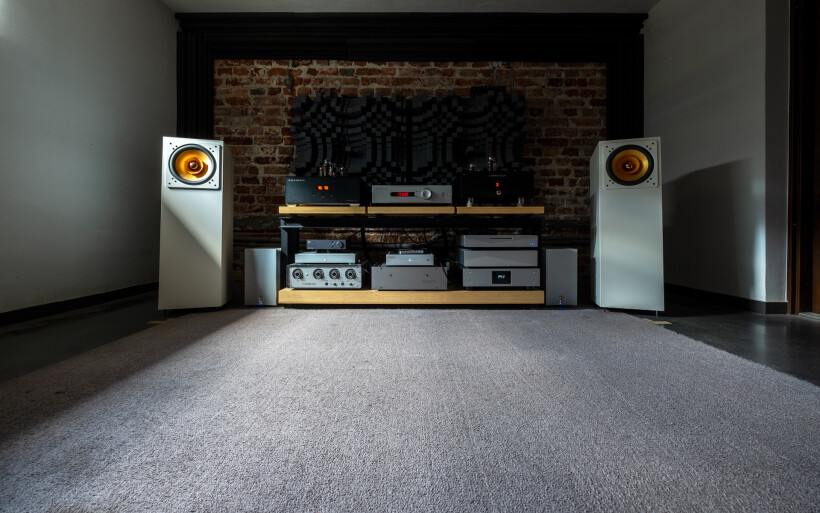 Since Jazzon marks my fourth Cube Audio assignment, the usual riddles related to its positioning and suitable hardware were solved multiple times already. I had to simply follow Srajan’s well-known widebander protocol as described in his reviews and map whether it still applied, but honestly the odds of that routine any off this time around were pretty much non-existent. My crib’s modes dictate the best spot for the listening chair that can’t move back or forth by more than 30cm. Any auditions outside of that safe zone result in bass either sucked in, or stronger than it should be. On top of that, speaker products create their own spacing demands; some need to stay far away from the nearby walls, while others benefit from being literally glued to them. All Cube Audio types I had the pleasure of reviewing were enjoyably easygoing on that score and unsurprisingly so was the Jazzon. About one meter distance to the neighboring surfaces and gentle toe in was all it needed to flaunt proper imaging skills and hefty nicely controlled bass, which implied its full readiness for action.
Since Jazzon marks my fourth Cube Audio assignment, the usual riddles related to its positioning and suitable hardware were solved multiple times already. I had to simply follow Srajan’s well-known widebander protocol as described in his reviews and map whether it still applied, but honestly the odds of that routine any off this time around were pretty much non-existent. My crib’s modes dictate the best spot for the listening chair that can’t move back or forth by more than 30cm. Any auditions outside of that safe zone result in bass either sucked in, or stronger than it should be. On top of that, speaker products create their own spacing demands; some need to stay far away from the nearby walls, while others benefit from being literally glued to them. All Cube Audio types I had the pleasure of reviewing were enjoyably easygoing on that score and unsurprisingly so was the Jazzon. About one meter distance to the neighboring surfaces and gentle toe in was all it needed to flaunt proper imaging skills and hefty nicely controlled bass, which implied its full readiness for action. The Jazzon’s high in-room compliance wasn’t any news to me, but it surely will be to many purist widebander fans. Although its breed is particularly known for beaming directivity that calls for steeply angled positioning, let me stress again that this guideline truly is counterproductive in case of today’s full-ranger. Cube Audio’s in-house developed drivers achieve top spatial accuracy upon tilting them inwards no more than 5-10° and any higher angles mess up their imaging capabilities. In my fairly small 23m2 room that setting was the ticket, but if I had a larger floor at my disposal I’d gladly move Jazzon’s cabinets away from the front wall and without any toe in at all. That extra breathing space would result in even greater aural depth without paying up in the imaging currency, but it is what it is. Naturally the closer the Jazzon was to the nearby walls, the higher its bass output became. Considering its inherently slamming disposition however, I’d still hear stout bottom end even upon positioning both its boxes in the middle of a larger room. This I’m certain of.
The Jazzon’s high in-room compliance wasn’t any news to me, but it surely will be to many purist widebander fans. Although its breed is particularly known for beaming directivity that calls for steeply angled positioning, let me stress again that this guideline truly is counterproductive in case of today’s full-ranger. Cube Audio’s in-house developed drivers achieve top spatial accuracy upon tilting them inwards no more than 5-10° and any higher angles mess up their imaging capabilities. In my fairly small 23m2 room that setting was the ticket, but if I had a larger floor at my disposal I’d gladly move Jazzon’s cabinets away from the front wall and without any toe in at all. That extra breathing space would result in even greater aural depth without paying up in the imaging currency, but it is what it is. Naturally the closer the Jazzon was to the nearby walls, the higher its bass output became. Considering its inherently slamming disposition however, I’d still hear stout bottom end even upon positioning both its boxes in the middle of a larger room. This I’m certain of.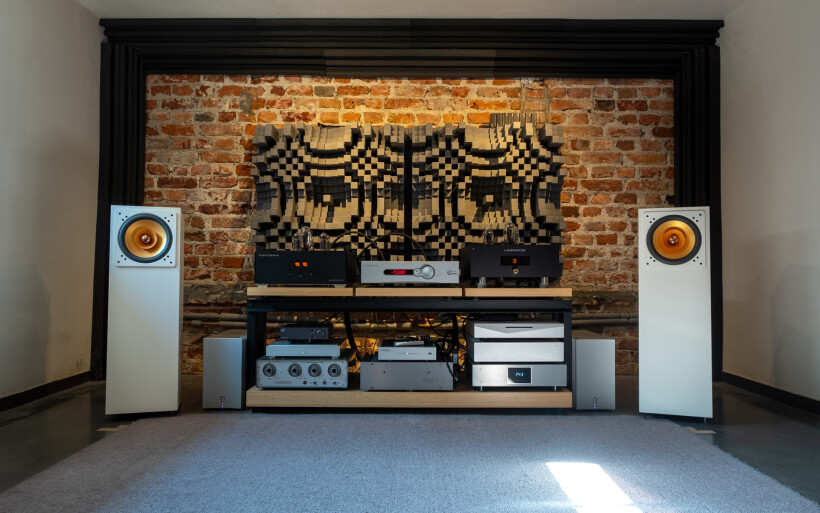 The choice of amps tailored to work well with the Jazzon neither was complex nor difficult to make. It’s no secrecy that such speakers enjoy high output impedance that translates into low damping factor. The lower that value is, the lesser control an amplifier has over a wideband transducer’s rear strokes. The more freely its cone moves, the more air it pushes into a transmission line and that impacts bass quantity. More importantly, this particular dependency renders most modern muscular class AB/D amps as unfit for today’s job. Most are high feedback low output Ω designs that would limit the Jazzon’s bass and make it dry. I had no such hardware anyway, but the two at my disposal were awesome companions for it. Trilogy 995R and Enleum AMP-23R are respectively class A/AB zero-feedback designs that pack 50/25wpc into 8Ω, while their 0.25/0.4Ω outputs with this report’s nominal 10Ω load result in DF values of 40/24. That’s not exactly ideal, but very much workable. Here I have a confession to make. Although the Enleum’s predecessor the Bakoon was in my possession during previous two Cube Audio reviews, It didn’t occur to me to try it out with their subjects. As adorable as this amp was, I mistakenly thought that it had its critical spec far too high to bother. It didn’t. Since the Enleum AMP-23R is a very similar design, now I got the chance to rectify that rookie mistake.
The choice of amps tailored to work well with the Jazzon neither was complex nor difficult to make. It’s no secrecy that such speakers enjoy high output impedance that translates into low damping factor. The lower that value is, the lesser control an amplifier has over a wideband transducer’s rear strokes. The more freely its cone moves, the more air it pushes into a transmission line and that impacts bass quantity. More importantly, this particular dependency renders most modern muscular class AB/D amps as unfit for today’s job. Most are high feedback low output Ω designs that would limit the Jazzon’s bass and make it dry. I had no such hardware anyway, but the two at my disposal were awesome companions for it. Trilogy 995R and Enleum AMP-23R are respectively class A/AB zero-feedback designs that pack 50/25wpc into 8Ω, while their 0.25/0.4Ω outputs with this report’s nominal 10Ω load result in DF values of 40/24. That’s not exactly ideal, but very much workable. Here I have a confession to make. Although the Enleum’s predecessor the Bakoon was in my possession during previous two Cube Audio reviews, It didn’t occur to me to try it out with their subjects. As adorable as this amp was, I mistakenly thought that it had its critical spec far too high to bother. It didn’t. Since the Enleum AMP-23R is a very similar design, now I got the chance to rectify that rookie mistake.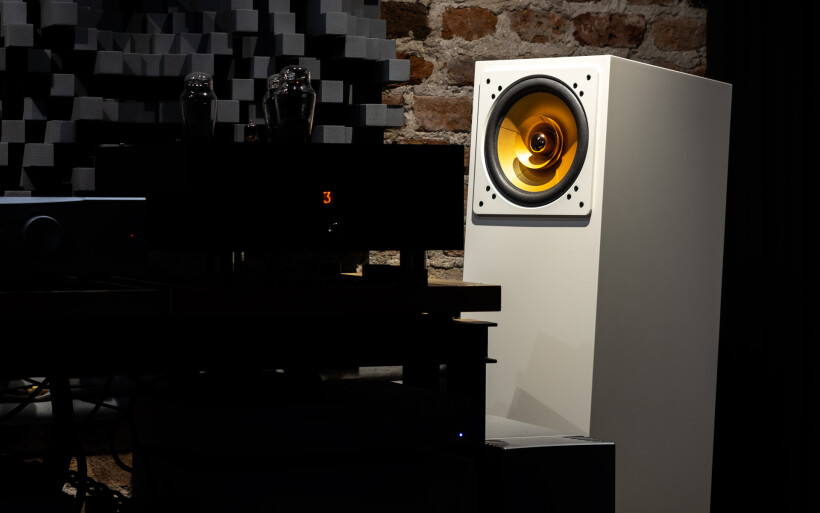 For some extra context let’s first address the sonic basics of the purist full-range kind. Such speakers’ sensitivity often in the ballpark of 100dB or more makes them particularly desperate for specialist low-power amps and enormous cabinets that incorporate either horns or folded transmission lines. Without voluminous internal loading these products are shy on bass, prickly, whitish, sharp, ethereal, shouty and not capable of rocking hard. This mandatory assistance impacts their size and naturally is a tall order for many living rooms. Still, aficionados of the full-range family accept its trade-offs and know how to work around them to achieve desirable results. Suffice it to say, after guesting several such products under my roof now I understand the value of traits these listeners pursue.
For some extra context let’s first address the sonic basics of the purist full-range kind. Such speakers’ sensitivity often in the ballpark of 100dB or more makes them particularly desperate for specialist low-power amps and enormous cabinets that incorporate either horns or folded transmission lines. Without voluminous internal loading these products are shy on bass, prickly, whitish, sharp, ethereal, shouty and not capable of rocking hard. This mandatory assistance impacts their size and naturally is a tall order for many living rooms. Still, aficionados of the full-range family accept its trade-offs and know how to work around them to achieve desirable results. Suffice it to say, after guesting several such products under my roof now I understand the value of traits these listeners pursue. In my book crossoverless full-range speakers are outstanding on spatial precision, directness, immediacy, articulation, quickness, energy and resulting high tangibility and impact, which is a lot to work with. I’ve also found their distinctively clear virtual projections quite unrivaled each time i.e. acoustic instruments and gentle voices recorded near mics are on the menu. The way I see it, no other speaker type is capable of executing such sensual tasks this convincingly, intimately, expressively and seductively, and none engages me from the on-stage perspective as effectively. I’m very fond of that highly appealing artful view that’s quite intoxicating at its very core, so getting back to any other regular speaker set’s more distant less enveloping approach isn’t easy. Each time when that happens my hearing sense needs to recalibrate for several days. Luckily with the Jazzon there was no need for that and my biases could roam happily uncontained.
In my book crossoverless full-range speakers are outstanding on spatial precision, directness, immediacy, articulation, quickness, energy and resulting high tangibility and impact, which is a lot to work with. I’ve also found their distinctively clear virtual projections quite unrivaled each time i.e. acoustic instruments and gentle voices recorded near mics are on the menu. The way I see it, no other speaker type is capable of executing such sensual tasks this convincingly, intimately, expressively and seductively, and none engages me from the on-stage perspective as effectively. I’m very fond of that highly appealing artful view that’s quite intoxicating at its very core, so getting back to any other regular speaker set’s more distant less enveloping approach isn’t easy. Each time when that happens my hearing sense needs to recalibrate for several days. Luckily with the Jazzon there was no need for that and my biases could roam happily uncontained. The product arrived on a pallet that stored two massive wooden crates with foamy liners, spikes, tiny discs for them and two hex keys inside. The entire cargo showed nearly 160kg on the scale, so two adults were needed to handle it. Interestingly, many speakers priced even well above the Jazzon feature cardboard housings, so the team Cube Audio gets two thumbs up from me for going the extra mile on packaging. Their latest effort set up and comfy in my digs instantly shined on all the fronts as described above thus behaved as expected. It also was a brilliant reminder that a smartly designed reasonably compact full-range speaker truly can sound ferocious, controlling, massive and enjoyably brutal without any augmentations at all. That fact alone is going to be a major wake up call for those who think that a single driver can’t possibly cover all bases without supportive woofers. Wrong. Jazzon made that point very clear by reaching admirably low, going all the way from there and very ballsy at that. Its performance wasn’t geared to tickle but shock and impress with spatial might, aural completeness and wicked slams just as the two Nenuphars before it. Although familiar, this was an awesome start nonetheless.
The product arrived on a pallet that stored two massive wooden crates with foamy liners, spikes, tiny discs for them and two hex keys inside. The entire cargo showed nearly 160kg on the scale, so two adults were needed to handle it. Interestingly, many speakers priced even well above the Jazzon feature cardboard housings, so the team Cube Audio gets two thumbs up from me for going the extra mile on packaging. Their latest effort set up and comfy in my digs instantly shined on all the fronts as described above thus behaved as expected. It also was a brilliant reminder that a smartly designed reasonably compact full-range speaker truly can sound ferocious, controlling, massive and enjoyably brutal without any augmentations at all. That fact alone is going to be a major wake up call for those who think that a single driver can’t possibly cover all bases without supportive woofers. Wrong. Jazzon made that point very clear by reaching admirably low, going all the way from there and very ballsy at that. Its performance wasn’t geared to tickle but shock and impress with spatial might, aural completeness and wicked slams just as the two Nenuphars before it. Although familiar, this was an awesome start nonetheless. Upon listening to the Jazzon for the first time, all the fond memories I had about the Nenuphar were alive once more, in particular how palpable, pounding, elastic and texturally sorted the latter’s bass was. Although not quite as tectonic, the newcomer wasn’t too far off on that count and just so didn’t feel any hollow, dry or limited. It packed a punch powerful enough to dwarf many regular speakers and its downfiring port decompressed in a way that kept any room gain and following wobble at bay. This escape tunnel in combination with the Jazzon’s x-overless F10 Select units resulted in sonics sensibly gutsy, open-throated, rapid, vivacious and precise yet not any boomy, sluggish, bloated or unclear. These drivers fed with a matched amp as per Srajan’s prescription also hadn’t a clue how to sound abnormally angry, pale, tense or stiff. All in all, the Jazzon’s performance was the full-care package that would very quickly convert many naysayers into firm believers. Whilst the product was at my place, its cult grew a new member amazed just about enough to let go his Dynaudio Confidence C4 floorstanders ASAP and rework his entire setup. That doesn’t happen every other day, or at the very least I don’t think it does.
Upon listening to the Jazzon for the first time, all the fond memories I had about the Nenuphar were alive once more, in particular how palpable, pounding, elastic and texturally sorted the latter’s bass was. Although not quite as tectonic, the newcomer wasn’t too far off on that count and just so didn’t feel any hollow, dry or limited. It packed a punch powerful enough to dwarf many regular speakers and its downfiring port decompressed in a way that kept any room gain and following wobble at bay. This escape tunnel in combination with the Jazzon’s x-overless F10 Select units resulted in sonics sensibly gutsy, open-throated, rapid, vivacious and precise yet not any boomy, sluggish, bloated or unclear. These drivers fed with a matched amp as per Srajan’s prescription also hadn’t a clue how to sound abnormally angry, pale, tense or stiff. All in all, the Jazzon’s performance was the full-care package that would very quickly convert many naysayers into firm believers. Whilst the product was at my place, its cult grew a new member amazed just about enough to let go his Dynaudio Confidence C4 floorstanders ASAP and rework his entire setup. That doesn’t happen every other day, or at the very least I don’t think it does. The Jazzon felt as big-bore, fearless and spatially gifted as its previously reviewed siblings, so just as them it kept on developing extra dynamic shove, muscular tissue and overall might along with volume increase. Although it remained clear, composed and texturally sorted regardless of SPL, its full-range flavor heavily infused with euphonic and expressive traits was always present. Knowing that the aurally fragile widebander kind feels most comfortable with minimalist instrumental music best served at reasonable volume levels, the Jazzon’s ability to cover these bases whilst roaring loud was unusual. In fact, its willingness to act this boldly and remain very much faithful to its delicate roots made it this much more special.
The Jazzon felt as big-bore, fearless and spatially gifted as its previously reviewed siblings, so just as them it kept on developing extra dynamic shove, muscular tissue and overall might along with volume increase. Although it remained clear, composed and texturally sorted regardless of SPL, its full-range flavor heavily infused with euphonic and expressive traits was always present. Knowing that the aurally fragile widebander kind feels most comfortable with minimalist instrumental music best served at reasonable volume levels, the Jazzon’s ability to cover these bases whilst roaring loud was unusual. In fact, its willingness to act this boldly and remain very much faithful to its delicate roots made it this much more special.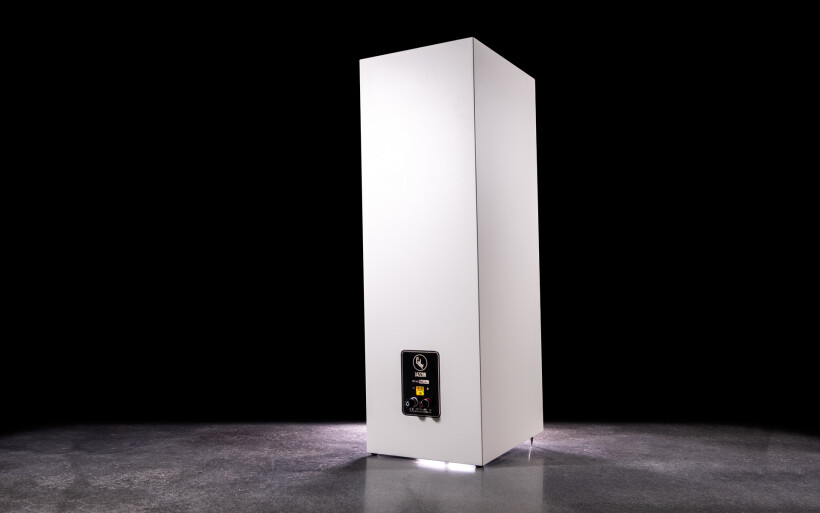 Although early on the Jazzon struck me as yet another well-developed full-range Cube Audio model free from any major surprises, its performance as heard at its makers’ booth in Munich was still fresh and telling. The newcomer felt thicker than the two Nenuphar models I’d heard yet didn’t forget how to portray vocals as distant or close as a given track had them, and always in pinpoint accurate, nicely outlined and moisturized fashion. It also knew well in what proportions tonal mass, propulsion and openness should blend to keep up with repertoire demands, so was a versatile highly adaptive specimen. It sounded as effortless and insightful as it was elegantly mature, tasteful and not flashy at all. It propagated lots of air my way, which in turn resulted in exploded dynamic contrasts that kept any hints of compression or struggle at the door. That’s quite the list of things to enjoy, but the Jazzon’s confrontation with sound|kaos Vox 3afw provided the extra insight needed to fully map what it truly was.
Although early on the Jazzon struck me as yet another well-developed full-range Cube Audio model free from any major surprises, its performance as heard at its makers’ booth in Munich was still fresh and telling. The newcomer felt thicker than the two Nenuphar models I’d heard yet didn’t forget how to portray vocals as distant or close as a given track had them, and always in pinpoint accurate, nicely outlined and moisturized fashion. It also knew well in what proportions tonal mass, propulsion and openness should blend to keep up with repertoire demands, so was a versatile highly adaptive specimen. It sounded as effortless and insightful as it was elegantly mature, tasteful and not flashy at all. It propagated lots of air my way, which in turn resulted in exploded dynamic contrasts that kept any hints of compression or struggle at the door. That’s quite the list of things to enjoy, but the Jazzon’s confrontation with sound|kaos Vox 3afw provided the extra insight needed to fully map what it truly was.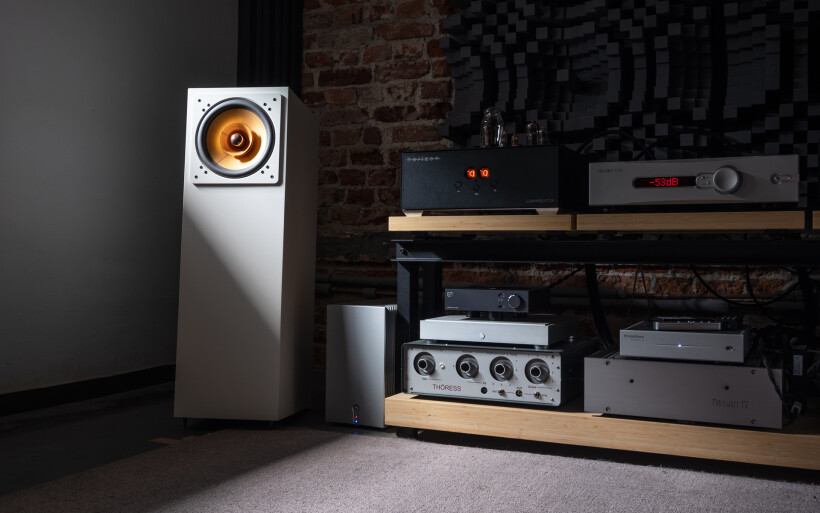 Martin Gateley’s monitors locate almost in the middle of my room and very closely to the listening chair, just so I can tap into their fabulous insight and imaging skills without trading in anything in particular. Going back and forth between this small stand-mount design and far larger Jazzon positioned much closer to my crib’s boundary walls rather drastically changed the entire perspective. Although both were sonorous explicit full-range types free from any hints of dilution and spatial confusion, the former’s outlines were finer, more precise and closer to my ears, while all the layers visible just behind these sound sources significantly increased the sensation of spatial depth. The Jazzon’s projections were more distant and uniformly stretched from left to right so less surrounding, and its massive attitude felt calmer versus the Vox 3afw’s lighter though noticeably more quicksilvery, twitchier and radiant footprint. After comparing both subjects it was rather clear where the Jazzon’s place among its kind was.
Martin Gateley’s monitors locate almost in the middle of my room and very closely to the listening chair, just so I can tap into their fabulous insight and imaging skills without trading in anything in particular. Going back and forth between this small stand-mount design and far larger Jazzon positioned much closer to my crib’s boundary walls rather drastically changed the entire perspective. Although both were sonorous explicit full-range types free from any hints of dilution and spatial confusion, the former’s outlines were finer, more precise and closer to my ears, while all the layers visible just behind these sound sources significantly increased the sensation of spatial depth. The Jazzon’s projections were more distant and uniformly stretched from left to right so less surrounding, and its massive attitude felt calmer versus the Vox 3afw’s lighter though noticeably more quicksilvery, twitchier and radiant footprint. After comparing both subjects it was rather clear where the Jazzon’s place among its kind was.
After hearing multiple full-range speakers at various shows and reflecting on how large and picky they were, I think that Cube Audio’s founders did an awful lot to domesticate this niche underground territory and make it as accessible as it possibly can be. That said, the Jazzon struck me as their most relaxed, approachable and peaceful design I’d heard to date. Although styled and sized for living rooms where casual listeners should thoroughly enjoy its crowd-pleasing personality, this still is a very serious brilliant performer no less. Infused with all the widebander perks minus most usual downsides, it won’t shy away from any music challenges and will easily surpass many its regular competitors on sensible control, quickness, articulation, heft, tone, tactility, immersion and spatial wickedness. If that’s not enough, Cube Audio’s big Nenuphar that sells for more than twice as much isn’t too far ahead on sonics, which makes the already highly accomplished Jazzon a bargain to boot. Well done!
Associated Equipment:
- Amplifier: Trilogy 995R, FirstWatt F7, Enleum AMP-23R
- DAC: LampizatOr Pacific (KR Audio T-100 / Living Voice 300B + KR Audio 5U4G Ltd. Ed.)
- Speakers: Boenicke Audio W11 SE+, sound|kaos Vox 3afw
- Transport: Innuos Statement, fidata HFAS1-S10U
- Preamplifier: Trilogy 915R, Thöress DFP
- Speaker cables: Boenicke Audio S3, LessLoss C-MARC
- Headphones: HifiMan Susvara
- Speaker signal conditioning: LessLoss Firewall for Loudspeakers
- Anti-vibration conditioning: 12x Carbide Audio Carbide Bases (under DAC, preamp and speakers)
- Interconnects: LessLoss Entropic Process C-MARC, Boenicke Audio IC3 CG
- Power components: Gigawatt PC-3 SE EVO+/LC-3 EVO, LessLoss C-MARC, LessLoss Entropic Process C-MARC, Boenicke Audio Power Gate, ISOL-8 Prometheus
- USB components: iFi audio Mercury3.0
- Rack: Franc Audio Accesories Wood Block Rack 1+3
- Network: Fidelizer EtherStream, Linksys WRT160N
- Music: NativeDSD
Retail prices of reviewed components in EU (excl. VAT):
- Cube Audio Jazzon (satin black/white): €7’990/pr
- Cube Audio Jazzon (high gloss/natural veneer): €9’900/pr
- Cube Audio F10 Select drivers: €2’990/pr
Manufacturer: Cube Audio


